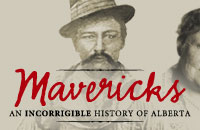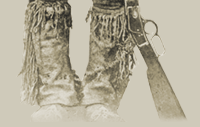 |

[ Project Plans | Essential
Questions | Knowledge Hunt | Glossary | Links ]
"Them's Fightin' Words"
Using Persuasive Reasoning or Debate to Investigate how Our Western
Heritage has Shaped Modern Points of View
Introduction
Students need to understand how issues around Alberta's heritage
still impact our society today. Concepts of land ownership, use
of resources, treatment of animals, and the image of Albertans have
gone through major changes over the past 100 years. How have our
ideas and visions of our western heritage changed? How have the
viewpoints of early Alberta ranchers defined our present attitudes?
Are they outdated? Are they still a part of who we are as Albertans?
Project Explanation
In this project, students will develop an appreciation of characteristics
and viewpoints from Alberta's past reflect people's
current attitudes toward issues connected to our interaction with
the land, natural resources, animals, and the First Nations peoples.
Students will create a persuasive argument and then either engage
in class debate or represent their case in a visual format. They
will have to conduct research in order to find and validate their
reasoning and justifications for their argument. The persuasive
arguments may then be presented in an oppositional debate format,
or students may create persuasive documents in order to sway others
to their viewpoint. Debate helps students to learn research, thinking,
communication and listening skills, as well as logical organization,
teamwork, and respect for viewpoints that are different from their
own.
Alberta Social Studies Curriculum Unit Connections
Grade Four - Alberta: The Land, Histories and Stories
4.1 Alberta: A Sense of the Land
4.2 The Stories, Histories and People of Alberta
4.3 Alberta: Celebrations and Challenges
Grade Five - Canada: The Land, Histories and Stories
5.1 Physical Geography of Canada
5.2 Histories and Stories of Ways of Life in Canada
Grade Six - Democracy: Action and Participation
6.1 Citizens Participating in Decision Making
Materials and Resources Needed
Procedures
At some point, we have all debated or used persuasive speech to
convince others to see our own point of view. It may have been in
order to have a later bedtime or about a significant issue. Students
will work to persuade others to accept and agree to their own point
of view on an issue that is related to Alberta's early history.
The idea of persuasive writing may be introduced by having students
brainstorm times they have had to try to persuade others to accept
their arguments.
Students could then begin to develop questions and issues that
would arise out of Alberta's past, including issues over land
ownership and use, animal rights, rodeo and the western image, First
Nation people's land claims and the historical viewpoints
of early Alberta figures. Possible questions might include:
- Can human beings really own the land?
- Is a specific Maverick an important part of Alberta's history?
- Was a specific Maverick a good representative of Alberta?
- Is the cowboy stereotype or tradition a positive and accurate
representation of Alberta?
- Is the Calgary Stampede an accurate representation of Alberta
or does it merely perpetuate the "Alberta" stereotype?
- Are animals treated fairly and humanely in an event like the
Calgary Stampede? Are there modifications needed or should we
respect our western heritage?
- Were animals treated fairly and humanely in Alberta's early
ranching history?
- Are animals treated fairly and humanely in Alberta's ranching
sector currently?
- Should domesticated animals act as a food sources for human
beings?
- Should branding be outlawed? Is there a better way to identify
animals?
- Should predatory animals that prey on cattle or wander into
urban settings be destroyed?
- Should ranchers have been allowed to settle on traditional First
Nations lands?
It should be decided on the framework for the presentation of student
learning and persuasive arguments. One option is that the whole
class may be broken down into small groups for formal debates on
a single or multiple issues. Another possible form of representation
may be used be individuals or small groups, depending on how they
would like to attempt to persuade their audience. These might include
posters, pamphlets, essays, plays, speeches, PowerPoint presentations,
digital videos, commercials or websites.
Students will then need to research and collect information and
arguments to support the viewpoint on an issue that either they
have chosen or that was given to them by their teacher (whether
or not it conforms to their own personal viewpoint or not). Sources
of information may include the Mavericks: An Incorrigible History
of Alberta site, other web sites, library books, information and
pamphlets from organizations such as Alberta Farm Animal Care Association
(AFAC) or the People for the Ethical Treatment of Animals (PETA),
and even experts such as ranchers, rodeo cowboys, or First Nations
leaders.
As the students research their issue, they can use the following
questions as a guide:
- What is the issue?
- What are the various viewpoints for and against the resolution?
- What is my position regarding the issue?
- What are the three main arguments for my point of view?
- What supporting evidence will I use for each argument?
- What arguments will the opposing viewpoints use?
- What arguments and evidence will I use to contradict these challenging
viewpoints?
The students will then work on creating their presentations using
the information they have gathered in order to convince their classmates
to adopt that viewpoint. They will need to consider their audience,
making sure they use strong statements, quotations, or powerful
statistics. They should make their position very clear and provide
reasons and evidence to support it. Their conclusion should reinforce
their position in a convincing manner.
They will then need to practice their presentation until they can
deliver it smoothly and with confidence. Diagrams, graphs, props,
or even costumes may be used to add to their presentation.
Assessment and Evaluation
- After the teacher and students collaboratively create a rubric,
students should use it as a guide for their learning as they are
working through the process, regularly checking that all the needed
elements are included in their work and revising as needed. The
rubric can then be used as a formal evaluative tool when they
have completed their project.
- Students may evaluate themselves and their peers using their
project rubric, examining each other's project for historical
accuracy, detail, and creativity.
- Students should use their journal to reflect upon their group
dynamics, how the problem solving process worked, their solutions
to the problem, what could have been done differently or better,
and any successes or frustrations they felt when working with
their group.
- The final student presentations may be videotaped in order to
be shared, re-examined, and evaluated. These may also be shared
or evaluated along with their parents or be presented at student-led
conferences.
Ideas for Enriching this Project
- Students could take responsibility for inviting special guests
or experts on their question to come into the classroom and act
as guest judges.
- Mathematical procedures in data collection and analysis could
be used to determine if the presentations have had an effect on
their own personal viewpoints about the issue being debated.
 |



![]()
